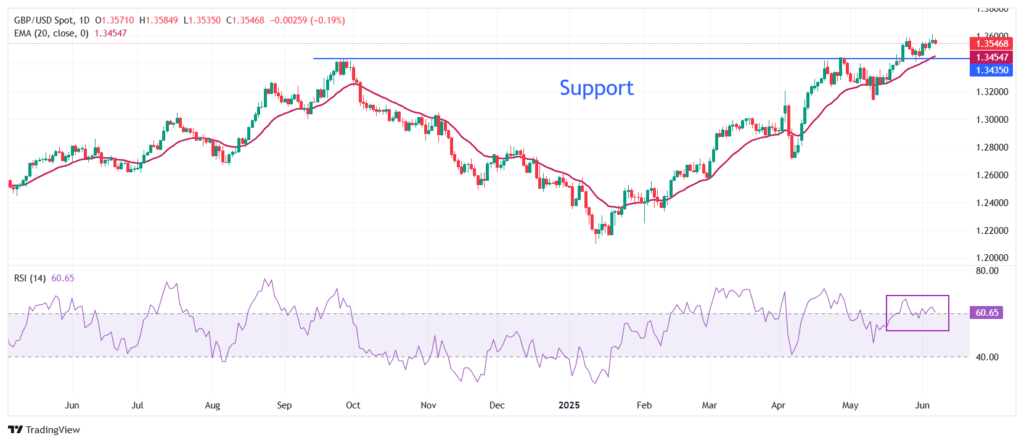
The GBP/USD pair dipped in the European session on Friday, from a three-year high of 1.3620 to 1.3535. The pullback comes ahead of the US Nonfarm Payrolls (NFP) release. Therefore, it is a key determinant of the dollar’s sentiment and strength in the foreign exchange market. In the meantime, uncertain Fed indications and softer global trade tensions are influencing the general economic perspective.
Will NFP Data Push Dollar Even Higher
The GBP/USD pair was under pressure as the US dollar gained strength before May’s NFP announcement. Due to investors hope that solid job data could delay rate cuts, the US Dollar Index touched 98.85. Estimates are that the 4.2% unemployment rate is expected to remain steady. Nevertheless, relative to 171,000 in April, US employers likely added 130,000 jobs in May.
Furthermore, pay growth will be watched closely. An average hourly earnings growth of 3.7% on an annual basis is projected, down slightly from April’s 3.8% growth. Monthly, a faster pace of 0.3% is projected, compared to the last 0.2%.
BoE Signals Calm as Global Risks Ease
Traders are reevaluating their expectations for the Bank of England (BoE) as the GBP/USD pair declines in value. Despite reducing bets on additional rate cuts by the BoE, the pound has declined. Due to persistent concerns about inflation, the central bank recently lowered rates to 4.25% but indicated a gradual policy approach.
According to the BoE’s Decision Maker Panel survey, fewer UK firms now cite US trade policy as a key concern. This follows a positive trade agreement with the United States and improved relations between Beijing and Washington.
President Trump and Chinese President Xi Jinping are reported to have had a call recently that eased trade tension fears for investors. Meanwhile, Fed officials continue to speak cautiously. Fed Governor Adriana Kugler noted upside inflation risks and steady labor demand, despite slower economic growth.
Can the GBP/USD Pair Sustain Its Bullish Momentum?
The GBP/USD pair has dropped to about 1.3535. However, it remains above the 1.3434 support level, which was reached during the peak in September 2024. The 20-day exponential moving average, sloping higher at 1.3443, maintains bullish momentum. At present, the 14-day Relative Strength Index at 60.00 shows strength.

The January 2022 high of 1.3750 is the level to watch from now onwards. The 20-day EMA can act as pivotal support on the lower side. Therefore, US employment data and additional Fed commentary may determine whether the GBP/USD rally resumes. Also, these elements will steer broader shifts in the forex market and the evolving economic outlook.
Why Market Sentiment Matters for the GBP/USD Movements?
The GBP/USD correction highlights how sensitive currency moves are to interest rate expectations and economic data. Traders are still split on the July Fed rate cut probability, which increased from 22.5% last week to 32.8%. The Fed’s response to labor trends and the stability of global sentiment will determine future movements in the GBP/USD exchange rate. Therefore, the forex market and the outlook for the economy are both in flux in such a data-driven environment.







